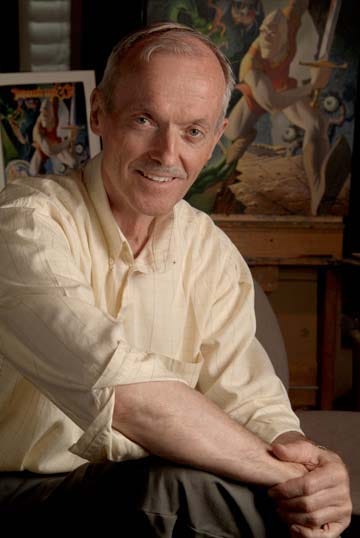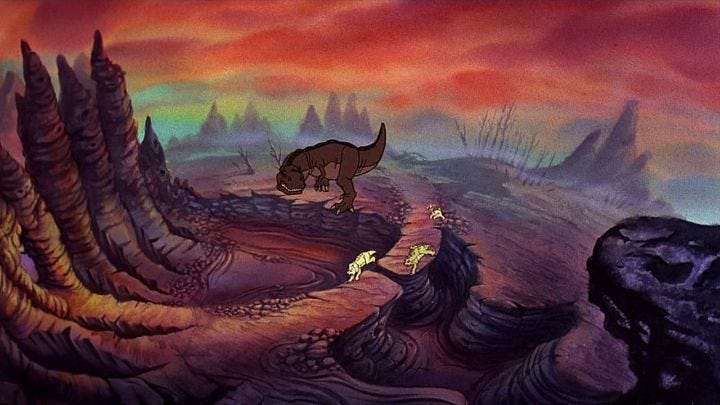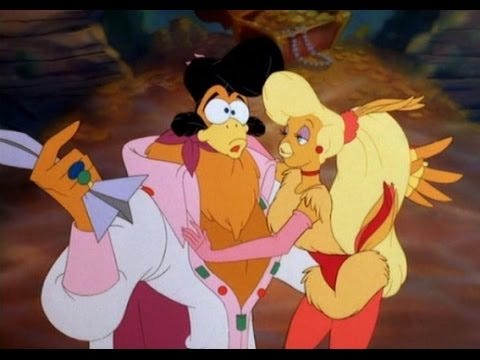
In the summer of 1982, a modestly budgeted animated film about a colony of field mice facing extermination arrived in theaters. "The Secret of NIMH," with its richly detailed backgrounds, fluid animation, and surprisingly mature themes of mortality and scientific exploitation, marked a distinctly different approach to children's entertainment than audiences had come to expect. The film carried a strange credit: "A Don Bluth Production." Few outside animation circles recognized the name, but within the industry, Bluth's emergence represented something monumental—a former Disney animator had not only defected from the animation giant but launched a competing vision of what animated storytelling could be.
Over the next fifteen years, Don Bluth's productions would carve out a significant alternate path in American animation. Films like "An American Tail," "The Land Before Time," "All Dogs Go to Heaven," and "Anastasia" established a distinctive counterpoint to Disney's increasingly formulaic Renaissance-era musicals. Where Disney offered reassuring tales of princesses finding true love, Bluth presented stories of vulnerable characters navigating genuinely dangerous worlds. While Disney perfected its Broadway-style entertainment formula, Bluth explored darker themes of loss, mortality, and the struggle for belonging in environments where happy endings weren't guaranteed but rather hard-won through genuine suffering.
This artistic counterbalance wasn't merely stylistic—it represented fundamentally different philosophies about childhood, entertainment, and the purpose of storytelling itself. Don Bluth's cinematic revolution challenged not just Disney's market dominance but its entire approach to children's entertainment, raising profound questions about what kind of stories young audiences need and what animation as a medium could accomplish.
The Disney Defector: Origins of an Animation Rebel

Don Bluth's journey from Disney acolyte to artistic rival contains elements worthy of his own animated drama. Born in El Paso, Texas, in 1937, Bluth grew up enthralled by Disney's early animated features. The studio's golden age productions like "Snow White and the Seven Dwarfs" and "Pinocchio" represented his artistic north star, leading him to join Disney as an animator in 1971 after a brief earlier stint in the 1950s.
By the late 1970s, Bluth had risen to prominence within Disney, working on films like "Robin Hood," "The Rescuers," and "Pete's Dragon." Yet despite his success, Bluth grew increasingly disillusioned with the company's direction under its post-Walt leadership. Animation budgets were being cut. Time-saving techniques were prioritized over craftsmanship. The artistic ambition that had defined Disney's earlier classics seemed subordinated to financial considerations.
"I think there was a feeling that the studio had lost its soul," notes animation historian Charles Solomon in his analysis of this period. The spirit of innovation and artistic risk-taking that had produced "Fantasia" and "Pinocchio" had given way to a more cautious, commercially driven approach.
On September 13, 1979—a date that would become known as "Black Friday" within Disney—Bluth and fellow animators Gary Goldman and John Pomeroy led an exodus of 11 animators from the studio. The defection, representing approximately 17% of Disney's animation department, sent shockwaves through the industry. Rarely had such a high-profile creative departure occurred, particularly with the explicit intent of founding a competing animation studio.
Bluth's rebellion wasn't merely professional—it was philosophical. He wasn't just leaving Disney; he was explicitly rejecting what he viewed as the studio's creative compromise. In establishing Don Bluth Productions, he sought to revive the craftsmanship, attention to detail, and emotional depth that had characterized Disney's golden age while pushing storytelling boundaries beyond what the increasingly conservative studio would permit.
Aesthetic Revolution: Darkness Visible

The most immediately striking aspect of Bluth's films was their visual distinctiveness. Where Disney animation of the era often featured simplified designs and less detailed backgrounds (particularly in their troubled 1980s period), Bluth championed a richly textured approach with complex characters, dynamic lighting effects, and meticulously rendered environments.
"The Secret of NIMH" announced this aesthetic revolution from its opening scenes. The film employed dramatic backlighting, multiple animation layers creating genuine depth, and sophisticated color palettes that shifted with the emotional tenor of each sequence. These technical choices weren't merely artistic flourishes but served the narrative's serious themes. The laboratory sequences featuring experimentation on animals utilized harsh lighting and clinical coloration that conveyed genuine menace. The muddy, rain-soaked exteriors created a palpable sense of vulnerability for the mouse protagonists.

This visual approach extended through Bluth's filmography. "An American Tail" depicted an immigrant mouse's journey through a New York City rendered not as a cartoon backdrop but as a towering, often threatening metropolis of looming shadows and precarious ledges. "The Land Before Time" portrayed prehistoric landscapes as both breathtakingly beautiful and terrifyingly vast. "All Dogs Go to Heaven" pushed visual boundaries further with sequences in a literally hellish underworld rendered with unsettling imagination.
Beyond the backgrounds and effects, Bluth's character animation embraced a fluid, expressive approach that prioritized emotional truth over simplified appeal. His characters didn't just move; they inhabited their environments with physical weight and presence. This animation philosophy created performances of remarkable subtlety—Mrs. Brisby's nervous determination in "NIMH," Fievel's wide-eyed wonder in "American Tail," Littlefoot's grief in "Land Before Time."
This technical and aesthetic approach wasn't mere stylistic preference. It reflected Bluth's fundamental belief that visual richness and complexity were necessary to tell stories of genuine emotional depth. The detailed worlds he created weren't just beautiful—they were environments where stakes felt real and characters' struggles had tangible weight.
Narrative Courage: Confronting the Unthinkable

While Bluth's visual approach distinguished his films, their most revolutionary aspect lay in their narrative willingness to confront difficult themes and emotions. Where Disney increasingly sanitized its fairy tales to remove disturbing elements, Bluth's stories deliberately explored the darker aspects of existence—death, loss, cruelty, and existential fear.
"The Land Before Time" offers perhaps the most striking example of this approach. The film centers on Littlefoot, a young Apatosaurus who witnesses his mother's death in a fight with a Tyrannosaurus rex. The sequence is rendered with unflinching emotional honesty—the mother's fatally wounded body, her final words to her child, and most devastatingly, Littlefoot's denial and grief afterward. In one particularly wrenching scene, Littlefoot briefly believes he sees his mother again, only to discover it's just his own shadow cast against a rock formation.
Such moments weren't exploitative but served profound narrative purposes. By acknowledging the reality of loss rather than avoiding it, Bluth's films validated children's actual emotional experiences. Many young viewers who had experienced grief found in these scenes a rare reflection of their feelings in media supposedly created for them.

This narrative courage extended throughout Bluth's filmography. "An American Tail" depicted the Mousekewitz family's migration to America as fraught with genuine dangers—separation, exploitation, and the crushing realization that the "streets paved with cheese" were a myth that masked a harsher reality. "All Dogs Go to Heaven" ventured into even darker territory, featuring a protagonist who initially displays genuine moral ambiguity and scenes involving kidnapping, gambling, and even a nightmare sequence in hell.
What distinguished these darker elements from mere shock value was their emotional purposefulness. Bluth understood that meaningful growth requires genuine challenges. His protagonists—often children or child-coded animals—weren't sheltered from life's harsher realities but rather developed resilience and wisdom through confronting them.
This approach reflected a fundamentally different philosophy about childhood than Disney's increasingly protective stance. Where Disney's Renaissance-era films reassured children that true love conquers all, Bluth's work suggested something more nuanced: that the world contains genuine darkness, but courage, compassion, and community provide the resources to navigate it.
Musical Counterpoint: Beyond Broadway

Even in their musical approaches, Bluth's films established a distinctive alternative to Disney's Broadway-influenced style. While Disney moved increasingly toward show-stopping production numbers and radio-friendly ballads, Bluth employed music more integrally within his narratives, often using songs to advance character development rather than as standalone performance pieces.
"Somewhere Out There" from "An American Tail" exemplifies this approach. Rather than a traditional duet where characters directly interact, the song features Fievel and his sister singing the same melody in different locations, unaware of each other but connected through longing—a poignant reflection of the separation that drives the film's plot. Similarly, "If We Hold On Together" in "The Land Before Time" serves as an emotional anchor amid the film's journey through grief and hardship rather than a triumphant character statement.
This musical integration reflected Bluth's holistic approach to storytelling, where every element served the emotional core of the narrative rather than functioning as a potential soundtrack single or marketing opportunity. Even when his later films like "Anastasia" moved closer to Disney's musical formula, Bluth maintained a distinctive sensibility that prioritized emotional authenticity over spectacle.
Commercial Realities: Success and Struggle

Bluth's artistic rebellion wasn't merely aesthetic but commercial. His departure from Disney represented a genuine challenge to the studio's market dominance in feature animation. The commercial trajectory of this challenge reveals much about both Bluth's impact and the challenges facing animation that diverged from established formulas.
The initial phase of this competition suggested Bluth might actually triumph. "An American Tail" (1986), produced with Steven Spielberg's Amblin Entertainment, achieved a stunning commercial success, grossing $47 million domestically and outperforming Disney's "The Great Mouse Detective" released the same year. "The Land Before Time" (1988) performed even better, earning $84 million worldwide.
This success wasn't just financially significant—it was existentially threatening to Disney's identity as animation's standard-bearer. Bluth had demonstrated that audiences would embrace animation with more complex emotional registers and challenging themes. Disney executives, observing this competitive threat, accelerated their own creative reinvention, leading to the Renaissance period beginning with "The Little Mermaid" (1989).
Yet as Disney regained its footing, Bluth's commercial fortunes wavered. "All Dogs Go to Heaven" (1989) opened the same day as Disney's "The Little Mermaid" and was thoroughly overshadowed. Subsequent films like "Rock-A-Doodle" (1991) and "Thumbelina" (1994) struggled to find audiences as Disney's polished musical approach dominated the market.
This commercial context creates a poignant irony: Bluth's challenge had pushed Disney to reinvent itself artistically, but that very reinvention then commercially marginalized Bluth's own work. By the mid-1990s, despite a moderate success with "Anastasia" (1997) at Fox Animation, Bluth's revolution had been largely subsumed by the industry's movement toward computer animation and Disney's renewed dominance.
Legacy of Meaningful Darkness: The Long Shadow of Bluth's Vision in Children’s Entertainment
Despite this commercial eclipse, Bluth's influence extends far beyond his direct commercial impact. His willingness to incorporate darker elements and emotional complexity into animated storytelling helped legitimize animation as a medium for more sophisticated narratives rather than merely children's entertainment.
This influence manifests clearly in subsequent animation development. Pixar's films, while visually and tonally distinct from Bluth's work, share his commitment to emotional authenticity and willingness to address difficult subjects. "Up" opens with a montage depicting infertility and death; "Inside Out" directly confronts depression and emotional complexity; "Coco" centers on themes of mortality and remembrance. While aesthetically different from Bluth's hand-drawn approach, these films continue his tradition of respecting children's capacity to engage with life's deeper challenges.
More directly, filmmakers who grew up with Bluth's alternatives to Disney frequently cite his influence on their own approach to storytelling. Animation directors like Travis Knight ("Kubo and the Two Strings") and singular voices like Cartoon Network's Rebecca Sugar have acknowledged Bluth's impact on their willingness to incorporate genuine emotional stakes in animation ostensibly for younger audiences.
Beyond specific works, Bluth's most significant legacy may be his demonstration that animation could sustain parallel approaches rather than requiring a single dominant aesthetic or narrative style. By establishing a viable alternative to Disney's approach—even temporarily—he expanded the medium's perceived possibilities.
The Consolation of Darkness
What makes Bluth's alternative vision most valuable isn't merely its contrast to Disney's approach but its distinctive emotional wisdom. At their core, Bluth's films suggest something profound about navigating a world that isn't inherently fair or safe: that acknowledging darkness is not the same as surrendering to it.
In "The Secret of NIMH," Mrs. Brisby isn't a warrior or chosen one but a mother forced by circumstance to find courage she didn't know she possessed. In "An American Tail," Fievel discovers that America isn't the promised land of his imagination but still manages to reunite with his family and build a meaningful life. In "The Land Before Time," Littlefoot's grief isn't magically resolved, but he finds a new family in friends who share his journey.
These narratives offer a different kind of consolation than Disney's more reassuring tales. Rather than promising that good-hearted protagonists will inevitably triumph through virtue alone, Bluth's stories suggest that even in a world containing genuine suffering and injustice, connection, courage, and compassion matter. The happy endings, when they come, feel earned precisely because the darkness that preceded them was treated with respect rather than minimized.
For children navigating their own experiences of disappointment, loss, or fear, this approach offers validation rather than distraction. Bluth's films say, in essence: yes, the world can be frightening; yes, terrible things sometimes happen; but you have the capacity to face these realities and still create meaning and find joy.
This philosophical core explains why Bluth's films, despite being less universally successful than Disney's, often inspire particularly intense devotion among those who connected with them in childhood. For certain viewers, especially those whose own experiences didn't match Disney's more optimistic worldview, Bluth's darker but ultimately hopeful alternatives provided rare recognition of their emotional reality.
In today's landscape of increasingly homogenized commercial animation, where market research and global sales potential often drive creative decisions, the distinctiveness of Bluth's vision appears even more valuable. His films remind us that animation need not choose between commercial viability and emotional authenticity—that the medium is capacious enough for multiple approaches, including those that acknowledge life's shadows.
The animation rebel who left Disney seeking to revive its lost artistic soul ultimately did something more significant: he demonstrated that animation's soul was never confined to a single studio or style but lives in its capacity to tell stories that respect the full spectrum of human experience, including its darker shades.
How did Don Bluth's films impact your understanding of what animation could be? Did their darker elements resonate with your own childhood experiences?




